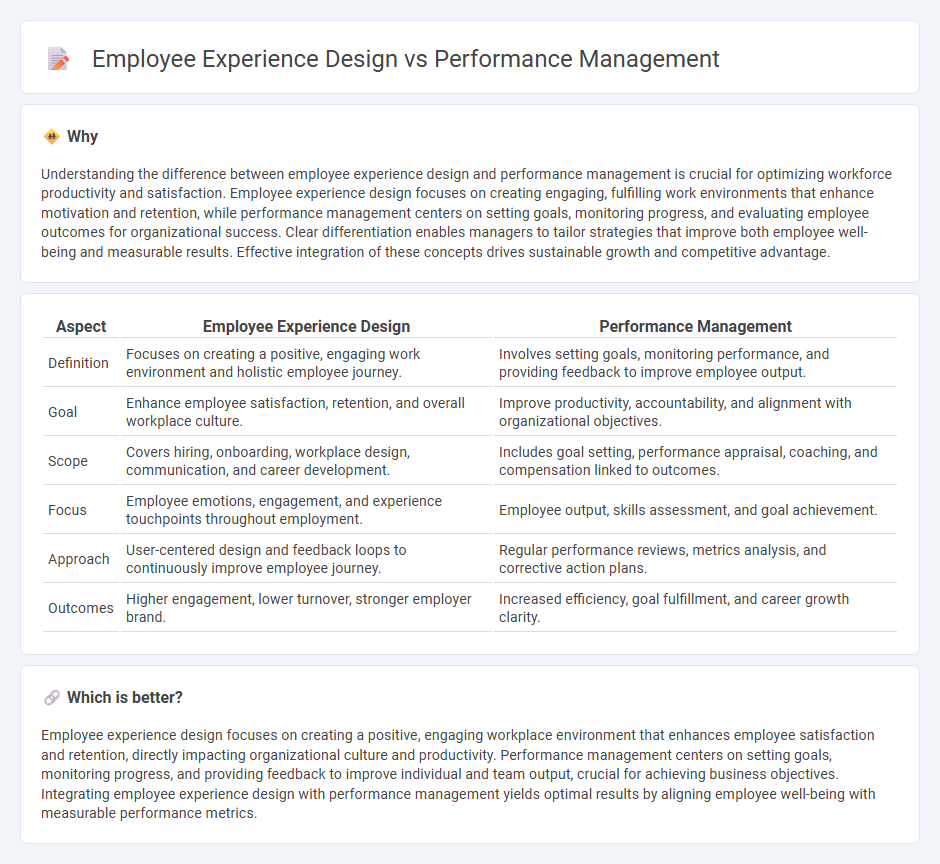
Employee experience design focuses on creating a positive and engaging work environment that enhances job satisfaction and retention. Performance management, by contrast, concentrates on setting goals, monitoring progress, and evaluating employee productivity to achieve organizational objectives. Explore these approaches to understand how they complement each other in driving workforce success.
Why it is important
Understanding the difference between employee experience design and performance management is crucial for optimizing workforce productivity and satisfaction. Employee experience design focuses on creating engaging, fulfilling work environments that enhance motivation and retention, while performance management centers on setting goals, monitoring progress, and evaluating employee outcomes for organizational success. Clear differentiation enables managers to tailor strategies that improve both employee well-being and measurable results. Effective integration of these concepts drives sustainable growth and competitive advantage.
Comparison Table
| Aspect | Employee Experience Design | Performance Management |
|---|---|---|
| Definition | Focuses on creating a positive, engaging work environment and holistic employee journey. | Involves setting goals, monitoring performance, and providing feedback to improve employee output. |
| Goal | Enhance employee satisfaction, retention, and overall workplace culture. | Improve productivity, accountability, and alignment with organizational objectives. |
| Scope | Covers hiring, onboarding, workplace design, communication, and career development. | Includes goal setting, performance appraisal, coaching, and compensation linked to outcomes. |
| Focus | Employee emotions, engagement, and experience touchpoints throughout employment. | Employee output, skills assessment, and goal achievement. |
| Approach | User-centered design and feedback loops to continuously improve employee journey. | Regular performance reviews, metrics analysis, and corrective action plans. |
| Outcomes | Higher engagement, lower turnover, stronger employer brand. | Increased efficiency, goal fulfillment, and career growth clarity. |
Which is better?
Employee experience design focuses on creating a positive, engaging workplace environment that enhances employee satisfaction and retention, directly impacting organizational culture and productivity. Performance management centers on setting goals, monitoring progress, and providing feedback to improve individual and team output, crucial for achieving business objectives. Integrating employee experience design with performance management yields optimal results by aligning employee well-being with measurable performance metrics.
Connection
Employee experience design directly influences performance management by creating work environments that align with employees' motivations and capabilities, fostering higher engagement and productivity. Tailored employee experience strategies provide actionable insights for performance evaluations, enabling managers to set realistic goals and offer personalized development opportunities. Integrating employee experience design into performance management systems leads to improved talent retention and organizational efficiency.
Key Terms
Performance Management:
Performance management centers on setting clear goals, continuous feedback, and evaluating employee outcomes to boost productivity and drive organizational success. It leverages data-driven performance metrics and regular appraisals to align individual contributions with business objectives. Explore how integrating performance management with modern tools enhances workforce effectiveness and engagement.
Key Performance Indicators (KPIs)
Performance management emphasizes quantifiable Key Performance Indicators (KPIs) such as productivity rates, goal achievement percentages, and efficiency metrics to assess employee output and organizational success. Employee experience design integrates these KPIs with qualitative factors like employee satisfaction, engagement levels, and workplace well-being to create a holistic approach that fosters motivation and retention. Explore how combining KPI-driven performance management with thoughtful employee experience design can enhance overall business outcomes.
Feedback Systems
Performance management centers on structured feedback systems aimed at evaluating and improving employee output through regular appraisals and goal tracking. Employee experience design integrates feedback as a dynamic, continuous loop to enhance engagement, satisfaction, and workplace culture by tailoring interactions to meet employee needs. Explore how innovative feedback systems transform both performance management and employee experience for organizational success.
Source and External Links
What Is Performance Management? The Complete Guide - This guide outlines performance management as an ongoing process involving goal setting and continuous feedback to enhance employee performance and organizational goals.
Performance Management - This resource explains performance management as a continuous process that includes goal setting, feedback sessions, and evaluation to align employee performance with organizational objectives.
Performance management that puts people first - This article discusses the importance of performance management in driving organizational success through goal setting, development, and rewards, leading to improved employee performance and retention.
 dowidth.com
dowidth.com